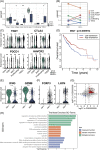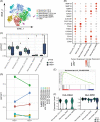Single-cell landscape identifies the immunophenotypes and microenvironments of HBV-positive and HBV-negative liver cancer
- PMID: 38251896
- PMCID: PMC10805423
- DOI: 10.1097/HC9.0000000000000364
Single-cell landscape identifies the immunophenotypes and microenvironments of HBV-positive and HBV-negative liver cancer
Abstract
Background: HBV infection leads to HCC and affects immunotherapy. We are exploring the tumor ecosystem in HCC to help gain a deeper understanding and design more effective immunotherapy strategies for patients with HCC with or without HBV infection.
Methods: Single-cell RNA sequencing series were integrated as a discovery cohort to interrogate the tumor microenvironment of HBV-positive (HBV+) HCC and HBV-negative (HBV-) HCC. We further dissect the intratumoral immune status of HBV+ HCC and HBV- HCC. An independent cohort, including samples treated with immune checkpoint blockade therapy, was used to validate the major finding and investigate the effect of HBV infection on response to immunotherapy.
Results: The interrogation of tumor microenvironment indicated that regulatory T cells, exhausted CD8+ T cells, and M1-like Macrophage_MMP9 were enriched in HBV+ HCC, while mucosa-associated invariant T cells were enriched in HBV- HCC. All subclusters of T cells showed high expression of immune checkpoint genes in HBV+ HCC. Regulatory T cells enriched in HBV+ HCC also showed more robust immunosuppressive properties, which was confirmed by cross talk between immune cell subsets. The ability of antigen presentation with major histocompatibility complex-II was downregulated in HBV+ HCC and this phenomenon can be reversed by immunotherapy. Two types of HCC also present different responses to immunotherapy.
Conclusions: There is a more immunosuppressive and exhausted tumor microenvironment in HBV+ HCC than in HBV- HCC. This in-depth immunophenotyping strategy is critical to understanding the impact of HBV and the HCC immune microenvironment and helping develop more effective treatments in patients with HCC.
Copyright © 2023 The Author(s). Published by Wolters Kluwer Health, Inc. on behalf of the American Association for the Study of Liver Diseases.
Conflict of interest statement
The authors have no conflicts to report.
Figures







References
-
- Venook AP, Papandreou C, Furuse J, de Guevara LL. The incidence and epidemiology of hepatocellular carcinoma: A global and regional perspective. Oncologist. 2010;15(suppl 4):5–13. - PubMed
-
- Levrero M, Zucman-Rossi J. Mechanisms of HBV-induced hepatocellular carcinoma. J Hepatol. 2016;64:S84–101. - PubMed
-
- Feng Z-Y, Xu F-G, Liu Y, Xu H-J, Wu F-B, Chen X-B, et al. . The immune microenvironment and progression of immunotherapy and combination therapeutic strategies for hepatocellular carcinoma. Hepatoma research. 2021;7:1192506.
Publication types
MeSH terms
LinkOut - more resources
Full Text Sources
Medical
Research Materials
Miscellaneous

